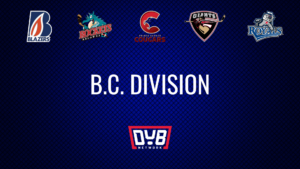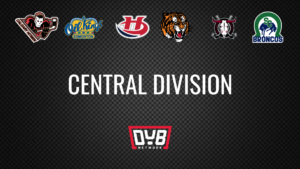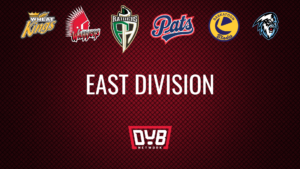The Portland Winterhawks have completed exactly 25% of their games in the 2019-2020 season.
I’ve taken a glance at the statistics to spot anything that catches my eye. My goal is to provide information beyond what someone could quickly view on the season statistics page.
Isaiah DiLaura and Joel Hofer are not included in the offensive numbers but rather have their own section.
Due to the limited sample size, Gabe Klassen’s numbers are not included.
A first glance at the main statistics broken down by age:
16’s – O’Brien, Stefan
17’s – Fromm-Delorme, Hanas, Jarvis, Knak, Kozak, Smythe
18’s – Brøndberg, Dureau, Gervais, Hanus, Newkirk, Nolan, Perna
19’s – Cicek, Ludvig, Mannek
20’s – Gilliss, Gricius, Quigley
Goals:
In 2018-2019, Portland scored 258 goals in 68 games for an average of 3.79 goals per game. So far, through 17 games, the Winterhawks have 61 goals (62 listed in the standings for a shootout victory) which translates to 3.58 goals per game.
Entering the season, Portland was looking to replace 123 goals as players graduated, were traded, or started their schooling early. Gone are the likes of Joachim Blichfeld (53), Josh Paterson (24), Cody Glass (15), Jared Freadrich (15), and Brendan De Jong (7).
One of the bigger questions entering the season was scoring from the blue line. Clay Hanus was 11th in team scoring in 2018-2019. The six returning defenders totaled 15 goals a year ago. Needless to say, head coach Mike Johnston and the rest of the coaching staff were looking for guys to step up.
The group of six returning defensemen has scored 16 goals through 17 games. Question answered.

Johnny Ludvig’s goal scoring is one of the main topics of conversation in early November. Coming into 2019-2020, the Winterhawks captain had seven goals registered to his name in the WHL. With a quarter of the season completed, the Kamloops, British Columbia, native already has eight goals. Ludvig spent countless hours working on developing his shot over the offseason, and it shows.
Clay Hanus has chipped in five goals in his 18-year-old season and is on pace for his best season in the WHL. The Excelsior, Minnesota, native keeps building off a strong finish to 2018-2019.
Kade Nolan registered his first WHL goal during the Central Division road trip. Nick Cicek also picked up a goal, shorthanded, after missing out last year.
Portland’s five 17-year-old forwards account for 24 of the team’s 61 goals (39.3%).
Seth Jarvis leads the team in goals with nine. If the Winnipeg, Manitoba, native stays on his current pace, he will finish with 36. He has scored goals in every possible situation — four at even strength, three on the power play, one shorthanded, and even via a penalty shot.
Cross Hanas scored perhaps the goal of the year in the first game. He picked the puck up on his stick and tucked it into the top corner similar to a lacrosse-style goal. Hanas’ hands are some of the best in the league. If not for some spectacular saves, Cross’ six goal total might be closer to Jarvis.
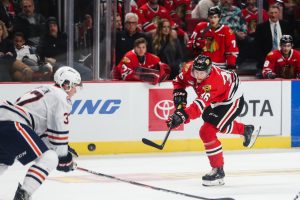
First-year import Simon Knak came over from Switzerland and has fit in well with Portland’s corps of 2002-born forwards. The Winterhawks released Michal Kvasnica in order to draft Knak. Kvasnica finished 2018-2019 with eight goals. Knak already has five on the young season. Four of his five goals have come at even strength. Portland is 4-1 when their first-round import draft selection scores.
Reece Newkirk has five goals on the campaign after a breakout year. His 23 goals a season ago helped him get drafted by the New York Islanders in the 2019 NHL Draft. The now 18-year-old may be having a slower start to the season in the goal category than he or some fans may want. However, his point production is still there. More on Newkirk later.
Portland only has three forwards of 19 years or older. Mason Mannek, Lane Gilliss, and Jake Gricius are providing leadership to a very young group up front. The trio has combined for 12 goals. Mannek scored a game-winning shootout goal against Vancouver but is not credited with an official goal on the stat sheet. Gricius has only scored one of his five goals via the power play after having 16 of his 27 with the man advantage a year ago.
Jaydon Dureau finished his 17-year-old season with 12 goals in 67 games (0.18 goals per game). After the first 17 games, Dureau has one goal — a number he would want to improve on. However, he is still producing offensively, just in a slightly different way. Again, more on Dureau later.
Assists:
Two assists can be awarded on every scoring play. Therefore, a total of 122 possible assists are available on Portland’s 61 goals. With a quarter of the season completed, Portland has 109 assists across all players, good for 89% of the available amount. When compared to how the team finished last year, Portland had 446 assists out of a possible 506 which is 88% of the maximum.
The 17-year-olds hold a large lead in goals for the team. However, both the 17- and 18-year-olds each have 37 assists.
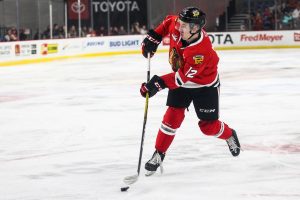
Newkirk leads the team lead in assists with 14 which is an average of 0.82 per game. In his draft season a year ago, Newkirk finished with 0.53 assists per contest. His role has shifted with the departure of Glass and Blichfeld. The early results show Newkirk is thriving in his new opportunity. One topic of conversation in the new world of analytics is how many primary/first assists a player has vs. secondary/second assists. In the case of Newkirk, 10 of his 14 are primary assists.
The Moose Jaw, Saskatchewan, native has assisted on goals by eight different players. Reece is also not relying solely on the power play to generate his assists. Only four of his assists have come with the man advantage.
Jarvis is second on the team in apples (hockey slang for assists) with 13. Slightly opposite of Newkirk, Seth has eight secondary and five primary assists. However, the secondary assists were not “cheap” assists where he touched the puck and the goal was scored 30 seconds later. Watching all of the goals where he picked up a secondary assist, Jarvis was the driving force on the vast majority of the scoring plays. Four of his eight secondary assists have come on the power play. Also of note, Newkirk received the primary assist on five of the eight where Jarvis was credited with the secondary. Like Newkirk, Jarvis has also assisted on goals by eight different players.
Third on the Winterhawks with 12 assists is overage forward Jake Gricius. Averaging an assist every other game last year, the Colorado Springs, Colorado, native has increased his production to 0.71. Should Jake continue on this trend, he would finish the season with 48 assists. The primary vs. secondary assist conversation is an even split for Gricius.
Where has Jaydon Dureau shown the most improvement from his 17- to 18-year-old season? In the playmaking category. The White City, Saskatchewan, native contributed 17 assists in 2018-2019, good for 0.25 a game. The 2001-born winger has 11 with 51 games remaining — a 44 assist projected season. One of his assists came on a shorthanded goal by Jarvis where Jaydon batted the puck out of the air back to Seth for a goal.

Robbie Fromm-Delorme is without a doubt the player who made the biggest gains in the setup department. During his rookie campaign, he produced 11 assists in 60 games played. Now in his draft season, Fromm-Delorme already has nine. Perhaps even more impressive, eight are primary assists. He has shown tremendous chemistry on a line with Hanas and Gricius. Six of Fromm-Delorme’s assists have been to one of his regular linemates.
Ludvig leads the way from the back end with eight assists, five coming via the power play. Hanus and Jonas Brøndberg each have five.
Also worth noting, Simon Knak has nine assists in the first quarter of the season. Similar to their success when he scores, Portland is undefeated (6-0) when Knak registers an assist.
All Winterhawks skaters who have appeared in eight or more games have registered at least one assist.
Plus/Minus:
Most are familiar with this statistic, but to be clear, a player earns a “plus” if they are on the ice for a goal scored at even strength or when a shorthanded goal is scored by their team. A player receives a “minus” if they are on the ice for a goal against at even strength or when a shorthanded goal is scored by their opponent. Being on the ice for a power-play goal for or against doesn’t impact a player’s plus/minus rating.
Given how many variables factor in this statistic, many in the hockey community feel this statistic isn’t the best representation of a player. They could just be jumping on or off the bench when a goal is scored, meaning they have no involvement in the goal. The player could also not be responsible for either the breakdown on defense or the zone time on an offensive shift.
That said until a better one is provided and available, I will continue to review this statistic.
Again leading the way statistically is the 17-year-old group with a combined +26 rating. The 18- and 19-year-olds each are +13.
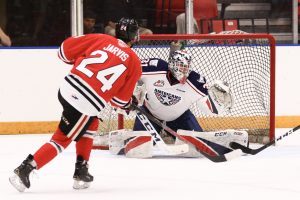
Seth Jarvis currently sits atop the Winterhawks roster with a +13 rating. Meanwhile, to no one’s surprise, Johnny Ludvig is a +11 after leading the team last year at +38.
Matthew Quigley ranks third on the Winterhawks with a +9, just slightly lower than Ludvig, whom he often pairs with on defense.
Nick Cicek, Jaydon Dureau, and Cross Hanas are all +6 with a quarter of the season in the rear-view mirror.
While still early, Portland has seven players in the minus category. Last season, only two Winterhawks finished the season with a minus rating. For perspective, when you compare this year’s stats to last year’s first quarter of the season, nine players in 2018 were in the minus rating. There is still a lot of hockey left to be played.
Power Play Statistics:
As of Monday, November 11, Portland’s power play ranks third in the Western Hockey League at 24.6%. The Winterhawks have converted on 16 of their 65 man-advantage opportunities.
Only the Medicine Hat Tigers (26.6%) and the Moose Jaw Warriors (25.8%) have a higher conversion rate on the power play so far this season.
A year ago, Portland finished sixth in the WHL with a 23.2% success rate. The Winterhawks scored 69 power-play goals in 297 opportunities.
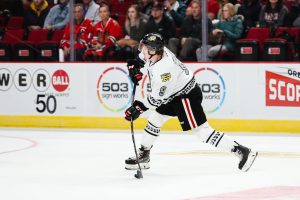
Portland’s power-play success can be credited to not relying on one individual player scoring. Johnny Ludvig leads the way with four power-play goals. Seth Jarvis and Lane Gilliss each are only one behind the captain. Clay Hanus and Reece Newkirk each have a pair of man-advantage goals. Jake Gricius and Simon Knak also have picked up a power-play tally.
The puck distribution on the power play is also impressive. Ludvig again holds the lead with five assists while Portland has the advantage. Four Winterhawks — Jarvis, Newkirk, Gricius, and Jaydon Dureau — are right behind him with four assists on the power play. 12 different players have registered at least one point on the Kyle Gustafson-led power play.
Portland has the ability to beat teams with a variety of different looks. While it is helpful to have someone like Joachim Blichfeld scoring 16 goals on the power play, a penalty kill unit can often have a harder time defending when there is not one key player to focus on.
Penalty Kill and Shorthanded Goals:

The Winterhawks boast the league’s second-best penalty kill as of November 11 with a success rate of 87.8%. Portland’s penalty kill has been red hot over the last 10 games as well. Dating back to the October 11 game in Red Deer, Portland has only allowed two power-play goals on 40 opportunities (95%). During this time, the Winterhawks have also scored two shorthanded goals to effectively draw to even. In eight of the last ten games, Portland’s opponents have failed to score on the power play.
Nick Cicek, Seth Jarvis, and Mason Mannek have registered shorthanded goals for the Winterhawks through the first 17 games. The 2018-2019 version of the Winterhawks finished with 11 shorthanded goals, so this year’s team is keeping up with the same pace.
Portland is in the middle of the pack (12th) for the most times shorthanded, 74, for an average of 4.35 times per game. Last season, they were forced to kill an average of 4.51 power plays per contest.
Goaltending:
Without a doubt, Joel Hofer has been the Winterhawks MVP in the first quarter of the season. As of November 11, he leads the league in goals-against average (1.90) for goalies who have played over five games. The St. Louis Blues signed netminder is second in the WHL behind Everett’s Dustin Wolf in save percentage (0.934). Wolf is only 0.002 ahead of Hofer for the top spot and has played two fewer games than Joel. The Winnipeg, Manitoba, native is tied for second in wins with 11, one behind Kamloops’ Dylan Garrand.
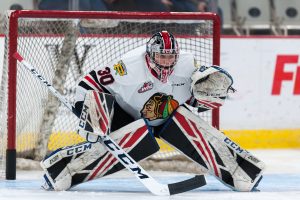
Hofer has started in 15 of Portland’s 17 games, thanks in part to a schedule which allows the 19-year-old to play the majority of games. However, the schedule begins to compact with games as well as other responsibilities.
The week of November 11 will be busy for Hofer. On Tuesday, he practices with Team WHL in advance of games on Wednesday and Thursday in the CIBC Canada Russia Series. He is expected to start one of the two games as Hockey Canada takes a closer look at prospects for its 2020 World Juniors team. Portland then has a three-in-three this Friday, Saturday, and Sunday.
Hofer is one of the leading candidates for a spot in Canada’s crease this season. Historically, Hockey Canada tends to select NHL drafted, signed 19-year-olds when possible. Hofer fits both of those categories and is playing at the top of his game right now.
Should Joel attend their selection camp — the roster should be announced around the week of November 30 — he would miss time for at least a week or two as camp is typically five days followed by a series of exhibition games. If Hofer makes the final roster, he would remain with Hockey Canada until the end of the 2020 World Juniors on January 5.
Assuming Hofer is gone for the full length of time, he would most likely miss Portland’s game on Friday, December 13, and not return until at least their game on Tuesday, January 7. During this stretch, the Winterhawks play nine games, including one three-in-three.
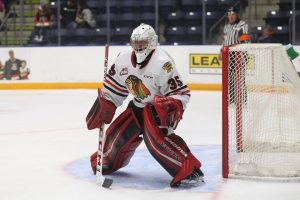
Presumably, 19-year-old Isaiah DiLaura will be asked to take the reigns as starter should Hofer depart. Portland has two other signed goalies in Dante Giannuzzi and Lochlan Gordon. So far, there has been no indication of who will receive the call-up.
Giannuzzi is currently playing in the MJHL where he holds a 3.86 goals-against average and 0.911 save percentage.
Meanwhile, Gordon has a 3.54 goals-against average and 0.907 save percentage in the AMHL.
While DiLaura’s first start at home may not have been his best start, he has started two games dating back to March 1. In his first game with Portland, he stopped 44-of-48 shots by the Medicine Hat Tigers. Winterhawks fans may recall seeing DiLaura with Prince George in the last two years. In 36 minutes of game time, Isaiah stopped 26 of Portland’s 27 shots.
What ends up happening with Hofer, along with the play of those filling in, will be a key component to the Winterhawks’ success during the middle portion of the 2019-2020 schedule.
Biggest Surprises:
It is hard for me to argue with the goal-scoring from Johnny Ludvig being the biggest surprise. I mentioned it previously, but the production from the Florida Panthers draft pick has been a welcome sight for Mike Johnston and the rest of the Winterhawks organization. While unrealistic to expect him to stay on this trajectory — he’s on pace for a 32-goal season — continuing to receive offensive production from Ludvig will be a key factor in Portland’s success as the season moves along.
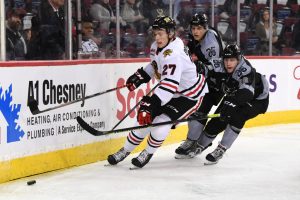
Next on my list is the play of both Simon Knak and Jonas Brøndberg. Both players have transitioned to the North American style of play much faster than expected. Sure, there is room for improvement, and Johnston always speaks about weighing the import players’ performance around the holiday break. Knak has 14 points and Brøndberg has six to start. The offensive production is already there. As both players continue to get acclimated, and more comfortable playing with less time and space, these numbers should continue to rise.
There are multiple different directions one could go next on the list of biggest surprises. However, I will give the edge to Robbie Fromm-Delorme. He is often overshadowed by some of the other 17-year-olds, but Robbie has played a key role in Portland’s early-season success. He has shown the ability to drive the play with Jake Gricius and Cross Hanas. Fromm-Delorme also has taken huge strides with his puck skills. At times last year, I would have categorized him as a good bubble hockey winger — someone who is really good in straight lines up and down the wall. However, this season, he is showing he has more tools in his toolbox. Fromm-Delorme is currently out of the lineup due to injury. Portland will miss his production and will hope he can pick up where he left off.
Biggest Opportunities:
I would first turn to the scoring column for Jaydon Dureau and Reece Newkirk. Both players are contributing offensively with assists. However, I feel both would look at their current goal totals and hope for more. The talent and opportunities are there — both are shooting at under 10% currently — so finding a few more goals from two of the 18-year-old leaders could be huge for Portland.
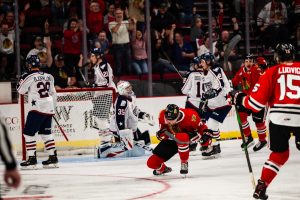
With Fromm-Delorme’s injury, top-six minutes are available as is an opportunity on the second power-play unit. Which players are going to step up with an increased role? How does Mike Johnston adjust the lines which appeared to have solid chemistry forming? Players and teams often talk about the “next man up” mentality — who will take advantage of this situation?
When looking at Cross Hanas’ stat line, six goals through 17 games seems a little lower than I would have anticipated. Twice, his goals have been WHL play of the night, so the high-end talent is there. In his draft-eligible season, can the young Texan find his scoring touch on a more consistent basis? He has shown he can score at every level, including the WHL. Hanas is currently trending toward a 24 goal season, which would be a healthy increase from his eight tallies a year ago. That said, I feel he has the potential to be a 30-goal scorer at 17 years old.
Overall:
Portland has a lot of positives going for them after 17 games. As mentioned above, they are getting scoring from a wide variety of sources, receiving quality goaltending, and their special teams are playing well. They sit second in the U.S. Division, three points behind Everett, and are currently ten points clear of the last wild card spot.

Of the Winterhawks’ 17 games, eight have come at home and nine on the road. Their next quarter of the season is a pretty even split between games within the division vs. games outside of the Pacific Northwest. The Winterhawks have eight games against U.S. Division teams, seven against the B.C. Division, and two against the East Division.
The home vs. road splits are also pretty even. Portland has nine games in the Rose City vs. eight on the road. Six of their nine home games will be played in the Veterans Memorial Coliseum and three in the Moda Center.
Over the course of the next 17 games, fans of the Winterhawks, and the U.S. Division will get a better sense of what the true identity of the 2019-2020 team will entail. The January 10 trade deadline is fast approaching. Portland has been active for the last several years. How the team performs over the next stretch of games will play a key role in how Mike Johnston, and the rest of the Winterhawks front office, handle the 2020 WHL trade deadline.
I will examine the numbers again once the season is half over which is right around the holiday break.



